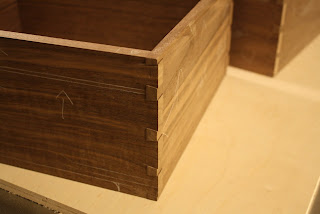I think this part is quite exciting since I have not done any inlay or more specifically marquetry before. I have not used one power tool or woodworking machine to do this operation! The only tool that was mechanical was my pencil :) It is strictly done by hand using only a very sharp utility knife, some carbon paper and of course my pencil. Let's begin!

I make sure I have a clean copy of the design...in this case the raven design. I first make sure to make small registration marks to easily align the drawing at each stage. I start by transferring the outline of the raven onto some nicely figured cherry veneer by placing carbon paper under the drawing. I carefully cut out the outline of the raven making sure to keep the knife perpendicular to the surface of the veneer sheet. I then take some nice contrasting walnut veneer and place it behind the cutout shape. After I am happy with the placement, I tape the walnut veneer in place with a couple strips of masking tape. I carefully trace the outline by making a light scoring cut with my knife making sure not to go all the way through in one pass. I then remove the walnut veneer to complete the cut.
After I am happy with the fit of the shape I then use white glue to glue the shape in place. I use a few strips of masking tape on the back of the piece to keep everything in place. I reposition the drawing by using my registration marks to transfer details of the body into place.


















 After all the tails are cut at the table saw I then look toward my scroll saw to remove the waste in between the tails. I make sure I stay far enough away from the the scribed line of the shoulders. This will be cleaned up later with the help of a guide block and chisel. Who says a scroll saw can't be used for fine joinery!
After all the tails are cut at the table saw I then look toward my scroll saw to remove the waste in between the tails. I make sure I stay far enough away from the the scribed line of the shoulders. This will be cleaned up later with the help of a guide block and chisel. Who says a scroll saw can't be used for fine joinery! At my bench I clean up the shoulders of the tails. I use the aid of a beefy guide block to help guide the chisel at a perfect 90 degree angle as I chop out the waste.
At my bench I clean up the shoulders of the tails. I use the aid of a beefy guide block to help guide the chisel at a perfect 90 degree angle as I chop out the waste. After all the shoulders of the tails have been squared up, it was time to mark the pin board. I carefully line up the tail board on the end of the pin board. I steadily hold the pieces in place and with a very sharp marking knife, I carefully trace the angle of the tails onto the pin board.
After all the shoulders of the tails have been squared up, it was time to mark the pin board. I carefully line up the tail board on the end of the pin board. I steadily hold the pieces in place and with a very sharp marking knife, I carefully trace the angle of the tails onto the pin board. 

 After I have made all the necessary drafting and was happy with all the proportions of the boxes, I jumped right into preparing the boards for the construction of the boxes.
After I have made all the necessary drafting and was happy with all the proportions of the boxes, I jumped right into preparing the boards for the construction of the boxes.